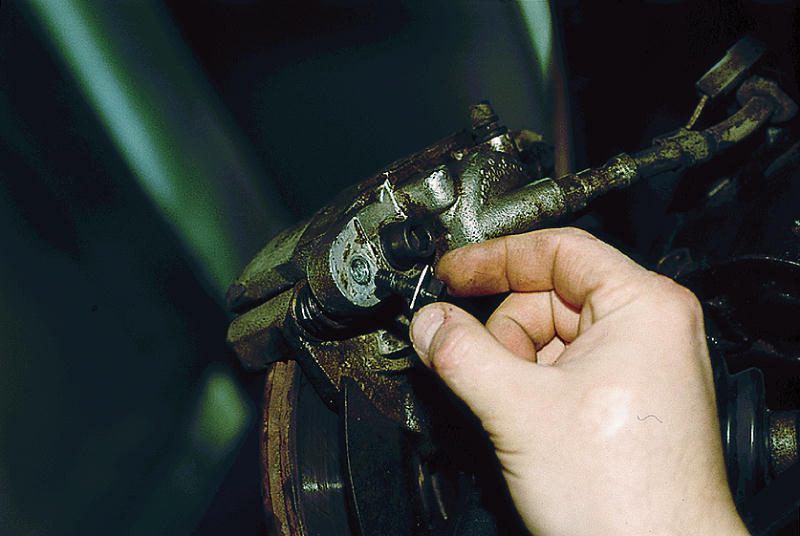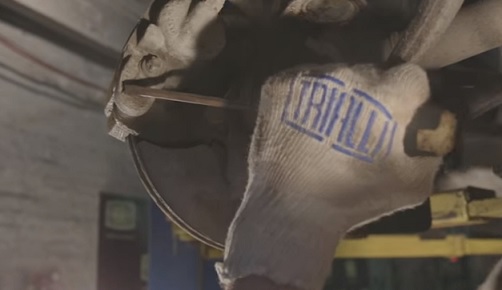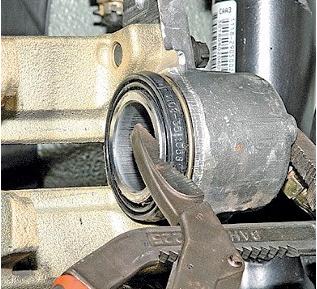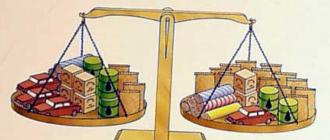Today we will tell you about how to independently and effortlessly replace front brake pads on your ten. For VAZ-2111 and 2112, the procedure is absolutely similar, so this instruction is universal. So we have a 2110 car with worn front pads. We will need new pads, a manufacturer of your choice, but we would recommend purchasing pads from well-known and trusted brands. This will avoid nasty squeaks during braking, increased wear of the brake discs, or, worst of all, poor-quality braking. I think it is not necessary to explain to the motorist what it threatens him with. So let's go. Raise the car with a jack and hang the wheel, remove it.
We beat off the locking plate from the lower caliper mounting bolt with a chisel and hammer.
Holding the 17 open-end wrench on the guide pin, and with the 13 wrench, unscrew the lower caliper mounting bolt 
And then we take it out together with the locking plate.

Prying with a screwdriver, we take out the caliper together with the cylinder.

We take out the brake pads themselves from the caliper guide.

In order to install new brake pads, we need to drive the piston itself (open it) as deep as possible into the brake cylinder itself.
It is convenient to do this either with large pliers or with a gas key.

A wear sensor is installed on the inner brake pad. Cut the wire going to the sensor.

Disconnect the sensor connector from the harness.
![]()
We take out the wire coming from the sensor from the clamps in the form of rubber rings that hold on to the brake hose.

After installing new pads (we install in the reverse order of removal), we connect the pad wear sensor connector to the connector in the wiring of our car and insert the sensor wire back into the brake rubber rings that are on the brake hose and connect the sensor to the block. That's all. After assembly, do not forget to fix the bolt with a stopper by pressing it against the fastening bolt. As you can see, there is nothing difficult in replacing pads on a VAZ-2111 No. If you have any questions, we will be glad to see you in our club VAZ-2110 and Priora!
Brake repair

We will show you how to quickly, with your own hands, replace the front brake pads in VAZ 2110 2111 2112 cars. wheel bolts, raise the car on a jack or lift to the desired level. We remove the wheel and first of all inspect the condition of the brake discs. We turn the brake fist outward and clean the brake caliper with a brush with metal bristles from stubborn dirt.
We push the pads with a flat screwdriver or a pry bar:

Before removal brake cylinder, it is necessary to unlock the lower bolt holding it:

Then we unscrew this bolt with a key or socket head by 13, remove it. We turn the cylinder on the upper guide clockwise and take it out, remove the brake hose from the bracket:

Now you can pull out the old brake pads and clean the side in those places where the pads are located. You can use a screwdriver and a brush with metal bristles for this. We also clean the brake cylinder from the inside, then check the condition of its rubber anthers.
If you have a professional tool for pressing the piston of the cylinder, use it, if not, you can do it like we do, using a clamp and an old block:

We take out the lower guide and check the condition of the rubber boot, remove the old grease with a rag or paper towel. We do the same with the top rail. Old grease may remain in the caliper bracket, it is better to remove it from there. Using a brush, apply a special lubricant to our guides, put rubber anthers in place. Apply grease to the bracket where the brake pads move. Graphite grease is used for all our purposes. We put the front brake pads in place, install the brake cylinder in place and press the pads with it. We collect everything in reverse order.
Video replacement of the front brake pads in the VAZ 2110 2111 2112:
The good condition of the brake pads of your VAZ 2110 is the key to a comfortable and safe ride. Perfectly working brakes will allow you not only to feel confident on the road, but also to avoid getting into traffic accidents. In the most extreme case, working brakes can even save your life. The instruction manual for the VAZ 2110 prescribes to change the brake pads when a certain mileage is reached. However, if you prefer an aggressive driving style, then the brake pads can wear out much faster than indicated in the instructions. Therefore, it is very important to check and, if necessary, replace worn brake pads in a timely manner.
In order to carry out the procedure for replacing worn brake pads on the front wheels of the VAZ 2110 model, you need to install the car on a flat area, fix it with a parking brake. Jack up the wheel and place a secure chock under the car.
After removing the rim, bend the edge of the stopper plate of the bolt of the lower mount of the wheel cylinder part. The function of this plate is to prevent spontaneous deployment of the fixing bolts.




Remove brake pads from seat. You may need to use a file to remove them, as if they are worn excessively, an edge may form on the edge of the guide piece.
In order to put fresh brake pads - push the piston rod deep into the brake cylinder.




Good afternoon. Today, a VAZ 2112 came to our car service. He came to us with terrible sounds when braking. We decided to immediately raise the car and see what was there with the pads and brake discs. After removing the wheel, it was clear that the brake pads were worn out. The discs were in good condition. Therefore, in this article we will tell you how to remove and replace the front brake discs with Ford Focus 2. It is advisable to change discs every 50-60 thousand kilometers.
| Vendor code: Front brake pads - GDB 1446 |
| Tools: To replace the front brake pads on VAZ 2110, 2111, 2112, you will need a 13", 17" wrench and wire cutters |
| Removal and replacement of the front brake pads VAZ 2110, 2111, 2112: |
| First of all, remove the front wheel. Then we bend the lock plate so that the bolt appears. |
| After that, unscrew the bolt, insert the 17" wrench inside, 13" wrench on top. |
 |
| Then remove the bolt from the caliper. |
 |
| We pry off the caliper and open the brake caliper. |
 |
| Then take out the brake pads. |
 |
| Then, using the key, we press the brake cylinder. |
 |
| Then we cut the wire, which is responsible for the wear of the pad. |
 |
| Next, disconnect the brake pad connector. |
 |
| Pull out the rest of the wire. |
 |
| Then we connect a new connector with a new block. |
 |
| Then we collect everything in the reverse order. The whole process of replacing brake pads on VAZ 2110, 2111, 2112 took us 30 minutes. After everything is assembled, we press the brake several times. The car started working like new. Good luck on the roads! |
Device brake system Vaz 2110: 1 – master cylinder hydraulic brakes, 2 - pipeline of the circuit "right front - left rear brake", 3 - flexible hose of the front brake, 4 - reservoir of the master cylinder, 5 - vacuum booster, 6 - pipeline of the circuit "left front - right rear brake, 7 - brake mechanism rear wheel, 8 - elastic pressure regulator drive lever, 9 - rear brake flexible hose, 10 - pressure regulator, 11 - pressure regulator drive lever, 12 - brake pedal, 13 - front wheel brake mechanism.
The service brake system of the VAZ 2110 is hydraulic, dual-circuit (with diagonal separation of circuits), with a pressure regulator, a vacuum booster and an indicator of insufficient brake fluid level in the reservoir. If one of the circuits of the brake system fails, the second circuit provides braking of the car, although with less efficiency.
The brake mechanisms of the front wheels of the VAZ 2110 are disc (on VAZ 21103, 21113 and 2112 cars - ventilated), with a single-piston floating caliper and a brake pad wear indicator. The brake mechanisms of the rear wheels of the VAZ 2110 are drum, with two-piston wheel cylinders and automatic adjustment of the gap between the pads and the drum. The automatic clearance adjustment device is located in the wheel cylinder.
The main brake cylinder VAZ 2110 is attached to the body vacuum booster on two pins. A translucent polyethylene tank with an emergency liquid level sensor is inserted into the holes in the upper part of the cylinder on rubber seals. The tank is marked with maximum and minimum fluid levels. Two screws are screwed into the bottom of the cylinder, limiting the movement of the pistons. The screws are sealed with copper gaskets. In front of the cylinder (along the direction of the car) a plug is screwed in, which serves as a stop for the return spring, also sealed with a copper gasket. The pistons in the master cylinder are arranged in series, the one closest to the vacuum booster actuates the right front and left rear brakes, and the one closest to the plug actuates the left front and right rear. High pressure sealing rubber rings (cuffs) of the main brake cylinder and rear wheel cylinders are interchangeable (nominal diameter - 20.64 mm). Sealing ring low pressure- with a groove, installed on the piston in contact with the vacuum booster rod.
The vacuum booster VAZ 2110 is located between the pedal assembly and the main brake cylinder and is attached to the pedal assembly bracket on two studs. The amplifier is a non-separable design; if it fails, it should be replaced. The simplest check of the efficiency of the amplifier: on a car with the engine turned off, we press the brake pedal several times and, while holding the pedal down, start the engine. With a working amplifier, with the start of the engine, the pedal should go forward. The failure of the VAZ 2110 brake system or the insufficient efficiency of the vacuum booster can also be caused by a leak in the hose that takes vacuum from the intake manifold.
pressure regulator rear brakes VAZ 2110 is attached with two bolts to the bracket in the left rear of the body. One of these bolts (front) also secures the fork bracket of the pressure regulator drive lever VAZ 2110. Due to the ovality of the holes for its fastening, the bracket together with the lever can be moved relative to the pressure regulator, changing the force with which the lever acts on the regulator piston. With an increase in the load on the rear axle of the car, the elastic lever is also loaded, transferring force to the pressure regulator piston. When you press the brake pedal, the fluid pressure tends to push the piston out, which is prevented by the force from the elastic lever. When the system comes into equilibrium, a valve located in the regulator isolates the rear brake cylinders from the master brake cylinder, preventing further increase in braking force on the rear axle and preventing the rear wheels from locking ahead of the front wheels. With an increase in the load on the rear axle, when the grip of the rear wheels with the road improves, the regulator provides more pressure in the wheel cylinders and vice versa - with a decrease in the load, the pressure drops. The regulator housing has a hole closed with a plug. Leakage of brake fluid from this hole indicates leaks in the sealing rings of the regulator.
The floating front brake caliper includes a caliper and a VAZ 2110 wheel cylinder, which are tied together with two bolts. With two other bolts, the bracket is attached to the fingers installed in the holes of the guide pads. These holes are filled with grease. Rubber protective covers are installed between the fingers and the guide pads. To the grooves of the guide brake pads are pressed by springs. The inner pad has a lining wear indicator. The cylinder is equipped with a piston with a sealing rubber ring of rectangular cross section. Due to the elasticity of this ring, a constant optimal gap between the brake pads and the disc is maintained.
Brake discs VAZ 2110 - cast iron. The minimum allowable disc thickness during wear is 17.8 mm for ventilated discs and 10.8 mm for non-ventilated discs, the maximum runout along the outer radius is 0.15 mm.
The rear wheel brake cylinders of the VAZ 2110 are equipped with a device for automatically maintaining the gap between the pads and the drum. The main element of the device is a steel spring split ring mounted on a piston with an axial clearance of 1.25-1.65 mm. Thrust rings (two per cylinder) are inserted with an interference fit, providing a shear force along the cylinder mirror of at least 35 kgf, which exceeds the force of the brake shoe coupling springs. When the brake linings are worn, the thrust rings are shifted by the wear amount under the action of the pistons. If the piston mirror is damaged under the action of mechanical impurities that have entered the brake fluid or formed as a result of corrosion (the presence of water in the brake fluid), the rings can turn sour in the cylinder and one or even both pistons will lose mobility. Brake cylinders VAZ 2110 in this case must be replaced.
The drive of the parking brake system VAZ 2110 is mechanical, cable, on the rear wheels. It consists of a lever, an adjusting rod, an equalizer of two cables, a shoe drive lever and a spacer bar.
Vacuum brake booster VAZ 2110

Vacuum device VAZ 2110: 1 - housing of the vacuum amplifier; 2 – a cup of the case of the amplifier; 3 - stock; 4 - adjusting bolt; 5 - rod seal;6 – a sealing ring of a flange of the main cylinder; 7 - diaphragm return spring; 8 - amplifier stud; 9 - tip mounting flange; 10 - valve; 11 - hose tip; 12 - diaphragm; 13 - cover of the amplifier case; 14 - sealing case; 15 - piston; 16 - protective cover of the valve body; 17 - air filter; 18 - pusher; 19 - pusher return spring; 20 - valve spring; 21 - valve; 22 - bushing of the valve body; 23 - stock buffer; 24 - valve body; A - vacuum chamber; B - atmospheric chamber; С, D – channels.
Brake pressure regulator drive VAZ 2110
![]()
Drive device brake regulator Vaz 2110: 1 - pressure regulator; 2, 16 - bolts for fastening the pressure regulator; 3 - bracket for the pressure regulator drive lever; 4 - pin; 5 - pressure regulator drive lever; 6 - axis of the pressure regulator drive lever; 7 – lever spring; 8 – body bracket; 9 - bracket for fastening the pressure regulator; 10 - elastic lever of the pressure regulator drive; 11 - earring; 12 – earring bracket; 13 - washer; 14 - retaining ring; 15 - bracket pin; A, B, C - holes.
Pressure regulator VAZ 2110

Scheme of the brake pressure regulator VAZ 2110: 1 - pressure regulator housing; 2 - piston; 3 - protective cap; 4, 8 - retaining rings; 5 - piston sleeve; 6 - piston spring; 7 - housing sleeve; 9, 22 - support washers; 10 - pusher sealing rings; 11 - support plate; 12 - pusher bushing spring; 13 - sealing ring of the valve seat; 14 - valve seat; 15 - sealing gasket; 16 - plug; 17 - valve spring; 18 - valve; 19 - pusher bushing; 20 - pusher; 21 - piston head seal; 23 - piston rod seal; 24 - plug; A, D - chambers connected to the main cylinder; B, C - chambers connected to the wheel cylinders of the rear brakes; K, M, H - gaps.
Master brake cylinder VAZ 2110

The device of the main brake cylinder VAZ 2110: 1 - the body of the main cylinder; 2 - low pressure sealing ring; 3 - piston drive circuit "left front-right rear brake"; 4 - spacer ring; 5 - high pressure sealing ring; 6 - clamping spring of the sealing ring; 7 - spring plate; 8 - piston return spring; 9 - washer; 10 - locking screw; 11 - piston drive circuit "right front-left rear brake"; 12 - connecting sleeve; 13 - tank; 14 - emergency brake fluid level sensor; A is a shame.
The brake mechanism of the front wheel VAZ 2110

Front device brake mechanism Vaz 2110: 1 - brake disc; 2 - guide pads; 3 - support; 4 - brake pads; 5 - cylinder; 6 - piston; 7 - pad wear indicator; 8 - sealing ring; 9 - protective cover of the guide pin; 10 - guide pin; 11 - protective cover.
Brake mechanism VAZ 2110 rear wheel

Scheme of the rear brakes VAZ 2110:1 – a nut of fastening of a nave; 2 - wheel hub; 3 - the lower coupling spring of the shoes; 4 - brake shoe; 5 - guide spring; 6 - wheel cylinder; 7 - upper coupling spring; 8 - expanding bar; 9 – a finger of the lever of a drive of a parking brake; 10 – parking brake drive lever; 11 - shield of the brake mechanism.
VAZ 2110 rear brake wheel cylinder device

Scheme of the rear brake cylinder VAZ 2110: 1 - stop pads; 2 - protective cap; 3 - cylinder body; 4 - piston; 5 - seal; 6 - support plate; 7 - spring; 8 - crackers; 9 - thrust ring; 10 - stop screw; 11 - fitting; A - a slot on the thrust ring.
Handbrake drive VAZ 2110

Hand brake device VAZ 2110:1 - button for fixing the lever; 2 – the lever of a drive of a parking brake; 3 - protective cover;
4 - thrust; 5 - cable equalizer; 6 - adjusting nut; 7 - locknut; 8 - cable; 9 - cable sheath.
Brake fluid level sensor VAZ 2110

Brake fluid reservoir cap device VAZ 2110 with level sensor: 1 - protective cap; 2 – sensor body; 3 – sensor base; 4 - sealing ring; 5 - clamping ring; 6 - reflector; 7 - pusher; 8 - bushing; 9 - float; 10 - fixed contacts; 11 - moving contact.


